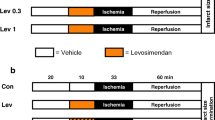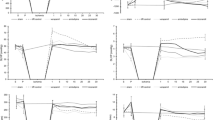Abstract
We demonstrated here that an initial treatment with aconitine- or barium-chloride-induced arrhythmias and resulted in reduced susceptibility of the heart to the induction of arrhythmias by a repeated drug treatment 24 h after the initial one, a delayed preconditioning cardioprotection. This delayed preconditioning was accompanied by enhanced expression of cardiac muscarinic M3 receptor and abolished by M3-selective antagonist. We conclude that muscarinic M3 receptors might play an important role in conferring the pharmacological preconditioning against arrhythmias. This study thus expands our understanding of the cellular function and pathophysiological roles of muscarinic M3 receptor and reconsolidates our view of cardioprotective effects of muscarinic M3 receptor on myocardium.


Similar content being viewed by others
References
Dana A, Skarli M, Papakrivopoulou J, Yellon DM (2000) Adenosine A1 receptor induced delayed preconditioning in rabbits: induction of P38 mitogen activated protein kinase activation and Hsp27 phosphorylation via a tyrosine kinase- and protein kinase C-dependent mechanism. Circ Res 86:989–997
Das DK (1993) Ischemic preconditioning and myocardial adaptation to ischemia. Cardiovasc Res 27:2077–2079
Fryer RM, Hsu AK, Nagase H, Gross GJ (2000) Opioid-induced cardioprotection against myocardial infarction and arrhythmias: mitochondrial versus sarcolemmal ATP-sensitive potassium channels. J Pharmacol Exp Ther 294:451–457
Fu M, Wu M, Wang JF, Qiao YJ, Wang Z (2007) Disruption of the intracellular Ca2+ homeostasis in the cardiac excitation–contraction coupling is a crucial mechanism of arrhythmic toxicity in aconitine-induced cardiomyocytes. Biochem Biophys Res Commun 354:929–936
Kaeffer N, Richard V, Thuillez C (1997) Delayed coronary endothelial protection 24 hours after preconditioning: role of free radicals. Circulation 96:2311–2316
Khisatmutdinova R, Baschenko N, Zarudiĭ FS, Gabdrakhmanova SF, Makara NS, Sapozhnikova TA (2006) Some aspects of the antiarrhythmic effect of glialin. Eksp Klin Farmakol 69:26–28
Marber MS, Latchman DS, Walker JM, Yellon DM (1993) Cardiac stress protein elevation 24 hours after brief ischemia or heat stress is associated with resistance to myocardial infarction. Circulation 88:1264–1272
Mest HJ, Forster W (1979) The central nervous effect of prostaglandins I2, E2 and \(\operatorname{F} _{2\alpha } \) on Aco-induced cardiac arrhythmia in rats. Prostaglandins 18:235–238
Niroomand F, Weinbrenner C, Weis A, Bangert M, Schwencke C, Marquetant R, Beyer T, Strasser RH, Kübler W, Rauch B (1995) Impaired function of inhibitory G proteins during acute myocardial ischemia of canine hearts and its reversal during reperfusion and a second period of ischemia: possible implications for the protective mechanism of ischemic preconditioning. Circ Res 76:861–870
Pönicke K, Heinroth-Hoffmann I, Brodde O-E (2003) Demonstration of functional M3-muscarinic receptors in ventricular cardiomyocytes of adult rats. Br J Pharmacol 138:156–160
Reiji H, Hajime O, Nilanjana M, Dipak K (2002) Pharmacological preconditioning with resveratrol: role of nitric oxide. Am J Physiol Heart Circ Physiol 282:1988–1995
Sanguinetti MC, Bennett PB (2003) Antiarrhythmic drug target choices and screening. Circ Res 93:491–499
Shi H, Wang H, Wang Z (1999) Identification and characterization of multiple subtypes of muscarinic acetylcholine receptors and their physiological functions in canine hearts. Mol Pharmacol 55:497–507
Sun JZ, Tang XL, Knowlton AA, Park SW, Qiu Y, Bolli R (1995) Late preconditioning against myocardial stunning. An endogenous protective mechanism that confers resistance to postischemic dysfunction 24 h after brief ischemia in conscious pigs. J Clin Invest 95:388–403
Takano H, Bolli R, Tang XL, Yang Z, Black R, Auchampach JA (1999) Activation of A1 or A3 receptors produces delayed protection against infarction in conscious rabbits by a mechanism involving KATP channels. Circulation 100:156
Wada K, Nihira M, Hayakawa H, Tomita Y, Hayashida M, Ohno Y (2005) Effects of long-term administrations of aconitine on electrocardiogram and tissue concentrations of aconitine and its metabolites in mice. Forensic Sci Int 148:21–29
Wang HZ, Shi H, Lu YJ, Yang BF, Wang ZG (1999) Pilocarpine modulates the cellular electrical properties of mammalian hearts by activating a cardiac M3 receptor and a K+ current. Br J Pharmacol 126:1725–1734
Wang HZ, Han H, Zhang L, Shi H, Scharm G, Nattel S, Wang ZG (2001) Expression of multiple subtypes of muscarinic receptors and cellular distribution in the human heart. Mol Pharmacol 59:1029–1036
Yang XM, Baxter GF, Heads RJ, Yellon DM, Downey JM, Cohen MV (1996) Infarct limitation of the second window of protection in a conscious rabbit model. Cardio Res 31:777–783
Yang BF, Lin H, Xu CQ, Liu Y, Wang HZ, Han H, Wang ZG (2005) Choline produces cytoprotective effects against ischemic myocardial injuries: evidence for the role of cardiac M3 subtype muscarinic acetylcholine receptors. Cell Physiol Biochem 16:163–174
Yang BF, Lin HX, Xiao JN, Lu YJ, Luo XB, Li BX, Zhang Y, Xu CQ, Bai YL, Wang HZ, Chen GH, Wang ZG (2007) The muscle-specific microRNA miR-1 regulates cardiac arrhythmogenic potential by targeting GJA1 and KCNJ2. Nature Med 13:486–491
Zhang Y, Yue P, Xiao J, Yu HY, Pan ZW, Lin DH, Lv YJ, Yang BF (2006) The association between connexin 43 and M3 subtype of acetylcholine muscarinic receptor is the new target of antiarrhythmias. Acta Pharmacol Sin 41:395–400
Acknowledgments
This work was supported by the National Natural Science Foundation of China (30672462) Specialized Research Fund for the Doctoral Program of Higher Education (20060226019, 20050226010), and the Heilongjiang Postdoctoral Sustentation Fund, China. Innovation Fund for Graduate student of Harbin Medical University, China (HCXS2006001).
Author information
Authors and Affiliations
Corresponding authors
Additional information
Yan Liu and Juan Du made equal contribution to this study.
Rights and permissions
About this article
Cite this article
Liu, Y., Du, J., Gao, Y. et al. Role of M3 receptor in aconitine/barium-chloride-induced preconditioning against arrhythmias in rats. Naunyn-Schmied Arch Pharmacol 379, 511–515 (2009). https://doi.org/10.1007/s00210-008-0376-6
Received:
Accepted:
Published:
Issue Date:
DOI: https://doi.org/10.1007/s00210-008-0376-6




